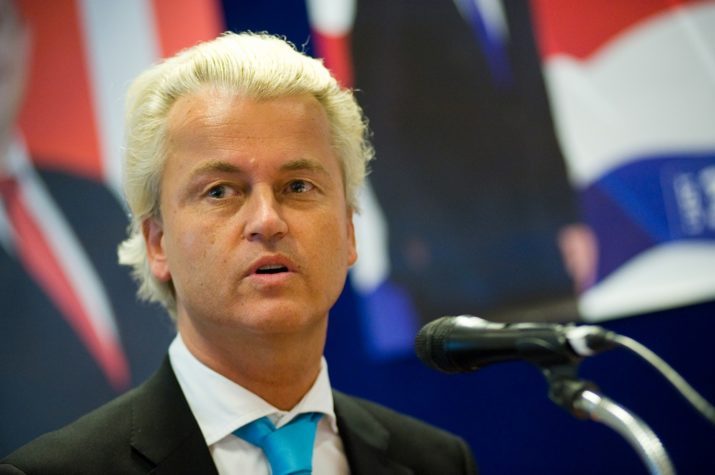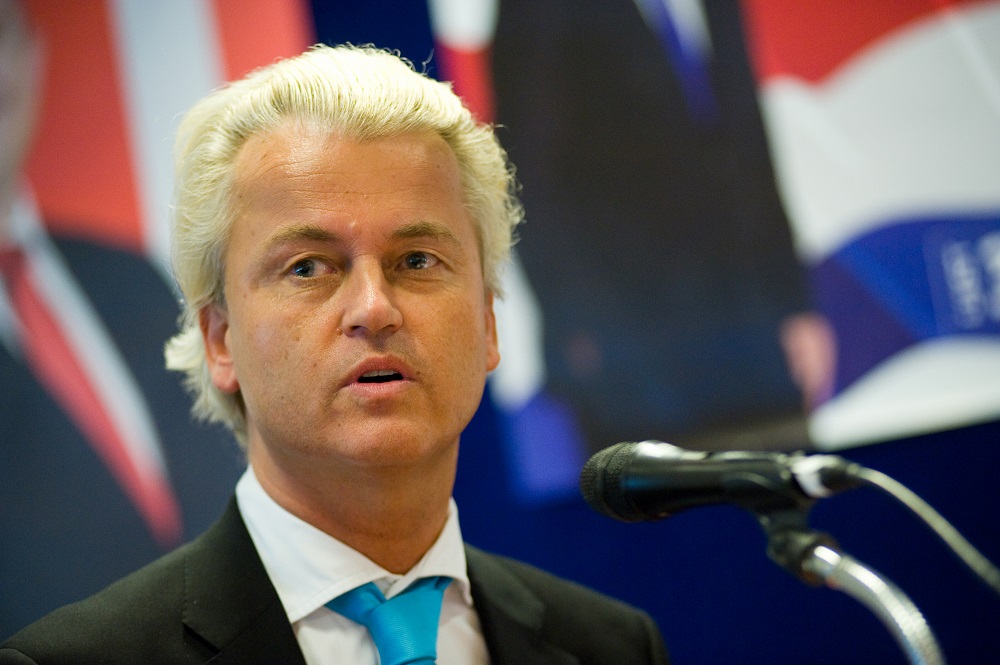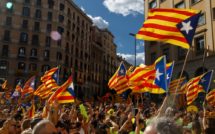

This is part of our special feature on Nationalism, Nativism, and the Revolt Against Globalization.
“Politicians from nearly all the established parties currently encourage Islamisation. They applaud every new Islamic school, every Islamic bank and every new Islamic court. They consider the Islam to be equal to our own culture. Islam or freedom? They don’t really find that important. But we do think it is important. The whole establishment, the elites – the universities, churches, trade unions, the media and politicians – are putting our hard fought for liberties on the line.”[1]
This quote is from Geert Wilders, the leader of the radical-right Party for Freedom (PVV) in the Netherlands. Although many observers are surprised by the rise of radical-right parties in a progressive country such as the Netherlands, we would claim that developments in the Netherlands are actually very representative for broader trends in (Western) Europe: the rise of nativism, most explicitly articulated by, yet not restricted to, radical right-wing parties.
In public opinion and scholarship alike, the increasing success of such right-wing parties have been understood in terms of a “resurgence of nationalism.” This interpretation makes sense as radical-right parties across Europe are indeed clearly nationalistic. Take the following quote of Wilders: “Our history compels us to fight a battle that is not an option but a necessity. After all this is a battle for the […] survival of the Netherlands as a recognisable nation; a country, that is about to say goodbye to its ancient roots in exchange for multiculturalism, cultural relativism and an European super state, all under the leadership of a self-satisfied political elite that has long lost the plot.”[2] The territorial entity (“the Netherlands”) should be “Dutch” by nature. Or as Wilders frames it somewhat tautological in the following quote, as preserving the “Dutch character” of the Netherlands: “What this cabinet was especially good at was ramping up mass immigration, the support of Islamisation and hollowing out the Dutch character of the Netherlands.”[3]
From nationalism to nativism
This is nationalism pur sang: a political ideology that aims to establish a congruence between, on the one hand, the political entity of the state with the socio-cultural entity of the nation (Anderson 1983; Leerssen 2006). More precisely, nationalism categorizes, by means of “national taxonomy,” human diversity into “nations,” which are held to possess a historically rooted cultural individuality; nationalism also demands primary political loyalty from its citizens; this state “derives its mandate from its incorporation of a constituent nation, so that civic loyalty to the state is a natural extension of ‘national’ (cultural, linguistic, ethnic) solidarity” (Leerssen 2006: 14).
Although such discourses – of which Wilders is the paradigmatic example – are clearly nationalistic, there are two reasons why nationalism is not the most productive term to understand the specificity of (new) right-wing politics in Europe. First, empirically, the phenomenon of nationalism is not exclusively a right-wing phenomenon. Its fundamental assumptions and principles are generally accepted, across the political spectrum, and, in various domains of social life such as the public sphere (Billig 1995; Leerssen 2014). Second, conceptually, nationalism is too broad to account for the specificity of such discourses; in definitions of nationalism, “being native,” being “truly American” or “truly Dutch,” is just one of the characterizing aspects (Bonikowski & DiMaggio 2016). Although nationalism is inherently relational as it is predicted on the assumption that there are other nations as well (no identity without alterity), in nationalism, the nation’s alterity is often either not mentioned explicitly and/or it is not seen as threatening to the nation. When the entities constituting the nation’s alterity become explicit, and when they are explicitly deemed as a threat to the national community, then we should rather speak of nativism. Nationalism is thus the ideological background in which nativism is embedded and from which the latter emanate.
Higham’s nativism(s)
Before we further discuss the usefulness of nativism to understand recent right-wing parties, we first turn to the most relevant study on the topic that still proves relevant and inspirational for contemporary scholars of nativism, John Higham’s seminal Strangers in the Land. Patterns of American Nativism, 1860-1925 (1955). He defines nativism as an “intense opposition to an internal minority on the ground of its foreign (i.e. “un-American”) connections.” (2011: 4). Empirically, Higham convincingly provides an historical analysis of American nativism by showing the complex and dynamic co-existence of its three main subtypes, all targeting minorities from European and/or Asian extraction. The first subtype is religious nativism, which saw European Catholic minorities as a threat to the American religious and political life. The second subtype is political nativism, mainly in the guise of the “Red Scare,” saw leftist ideas and practices (e.g. strikes) imported from Europe as a threat to the typically American liberalism. Lastly, racial nativism operated on the hierarchical distinction between on the one hand true Americanness (based on the conflation between white supremacy, Englishness and Americanness) and on the one hand, inferior yet threatening races such as Blacks, Asians, and Southern and Eastern Europeans.
Understanding European nativism
Although published in 1955 with the United States between 1860 and 1925 as its object of analysis, Higham’s book proves to be useful for the purpose of understanding nativist politics in contemporary Europe. First, his definition is useful (“intense opposition to an internal minority on the ground of its foreign […] connections.” (2011: 4) because it is more specific than the terms “nationalism” or “xenophobia.” Second, his definition includes the possibility of framing ‘native’ elites as a national threat (they are “native” yet “foreign” –so not “truly native”- to the nation at the same time). Last, his threefold subcategorization of nativism appears to be productive for many European cases. Inspired by Higham, for the Dutch context we distinguish between three subtypes of nativism, all revolving around the perceived threat of the nation, yet with varying emphasis: 1) religious nativism, problematizing Islam and Muslims; 2) class nativism, problematizing the ‘native’ elites seen as a threat to national identity, and 3) racial nativism, problematizing Black anti-racism.
Religious nativism
“If immigration continues, the Islamic culture in the Netherlands will keep growing – which I do not want – and we end up living in country that has not 1 million but many, many more Muslims who adhere to an ideology that directly opposes ours, then the Dutch identity will be lost […]. I want ours to safeguard our identity and this is why I want to put a stop to immigration.”[4]
With such claims, Wilders has not only dominated the public sphere in the Netherlands for more than fifteen years, but has also become a prominent voice in transnational anti-Islam circles. The trope of the Islamic invasion has been used time and again by populists, but also by more recent political figures such as Wilders’ intellectualistic and dandyish spinoff: Thierry Baudet. The chairman of his new party Forum voor Democratie often portrays Muslim minorities as a national threat, yet in different degrees of explicitness. Even when Baudet does not mention Muslims, they are always the implicit background against which the Netherlands is characterized. “Our free, tolerant, progressive, curious, humoristic, cheerful and democratic society is in a critical condition, even lethally wounded.” But as Wilders, Baudet sometimes also explicitly points the enemy: “Due to the arrival of large groups of (Islamic) migrants, there are several achievements and core values of our society which are under pressure now.”[5]
Anti-Islam rhetoric is often understood as emanating from secularism in (Western) European countries. We do not dispute that secularism plays an important role. It is, however, important to note that it is the understanding of secularism-as-typically-Dutch that gives it its special flavor. Rather than secularism as such, it is nativist secularism and a nativist rejection of Islam that is at work here because a specific national culture is at stake, not the general opposition between secularism and religion. That anti-Islam is nativist rather than fully secularist is shown by those who defend secularism while at the same time defining national and European cultures as “Judeo-Christian.” The main point is here not nationalistic (who are we as a nation) but rather nativistic: we are secular and/or Christian (and we do not have to agree on that), but what we are not is Islamic. In religious nativist discourses, the main concern is not so much the self-identity (which is highly contradictory and instable, shifting back and forth between (Judeo)Christian and secular self-images) but rather the Islam and Muslim minorities as a threatening alterity.
Class nativism
In addition to Muslims, nativists regard elites as a threat to the nation as well. This trope has been used time and again by populists (see the earlier quotes), including by Baudet’s Forum voor Democratie:
“Now we are under attack from an enemy we have never faced before. An atypical friend. An enemy who wears our own uniform. We are being attacked by those who should be protecting us. Those who should be guarding our integrity, our culture and our traditions: those who carry responsibility for the survival of the community; these people; precisely these people have – from within – turned against us.”[6]
In such discourses, this animosity towards national culture on the part of “native” elites is often connected to more concrete political processes and policy fields. Baudet for example, argues this elitist attitude is expressed in various ways:
“In the Netherlands, we are dealing with a social elite who are undertaking, what I call, an attack on the nation state, who undermine the Netherlands, who are hostile to the Dutch identity – hence multi-culturalism, open borders, the European Union. You see this across the board.”[7]
These examples greatly illustrate how in the nativist logic, the elites’ foreignness to the nation manifests itself in different degrees and with respect to different political domains. Elites are framed as “enemies from within” because they are too passive to protect the national culture, or they undermine the national culture more actively and deliberately. Baudet, Wilders and others often connect religious and political nativism by claiming that the Dutch elites either passively condone the threatening Islam, or actively promote Islam informed by their “multicultural” ideology. Similarly, the elites’ negative attitude towards their own national culture can vary from passive neglect, to active denial of national identity as such, often framed as “self-hate.” In the nativist discourses, both Muslims and national “native” elites are framed as foreign and not “truly native,” yet in different degrees. Elites are not as foreign as Muslims, yet still foreign enough to pose a threat to the Dutch national identity.
The elites’ foreignness is also often associated with supranational cooperation, especially in the framework of the European Union. Here, the alleged decrease of political sovereignty of nation-states in the European Union is presented as a threat to national cultural identity. Ironically, both established (VVD, Wilders’ PVV) and new (Baudet’s Forum voor Democratie) right-wing parties frame at the same time the superiority of their national culture in a broader European framework. When it comes to Islam as a threat to Dutch culture, many nativists define Dutch culture as a part of the free West more generally, being defined by transnational commonalities such as the Enlightenment, secularism, Christianity, and humanism. In other words, Europe as a cultural entity should be protected against the political project of the European Union, promoted by self-hating elites.
Racial nativism
The third type of nativism in the Netherlands is at once the most obvious one and the most tabooed: racial nativism. Racist practices and stereotypes undoubtedly abound in the Netherlands – for example, from statistics and public policy terminology (“Black schools”) to everyday speech, media coverages and racially biased police conduct (see for example, Essed 1991; Wekker 2016) – yet not every form of racism is informed by and connected to the idea that a certain group with a different phenotype/skin color is a threat to the nation. When racism is constitutive of a logic of who belongs to the nation and who does not, who is more “native” and who is more “foreign” and therefore a peril to the nation, it becomes racial nativism. The following quote from the prime minister’s campaign published several weeks before the 2017 national elections clearly shows racial nativism:
“We feel a growing unease when people abuse our freedom to wreck things here, whereas they actually came to our country for that very freedom. People who do not want to adjust, who denigrate our customs and reject our values. Who molest gays, who shout insults at women in short skirts or call ordinary Dutch citizens racists. I understand perfectly that people think: if you reject our country so fundamentally, I would prefer you to leave. This is what I feel too. Act normal or clear off.”[8] (italics added)
This quote includes not only religious nativism – i.e. references to conduct towards gays and women often attributed to Muslims and therefore seen as opposed to the essence of Dutch culture) – but also racial nativism. “Call[ing] ordinary Dutch citizens racists” refers to a relatively recent problematization of the Black Pete figure, the servile assistant of the Dutch Saint Nicolas. A strong anti-racism movement lead by (Black) activists Quisy Gario and Kno’Ledge Cesare (Jerry King Luther Afriyie) in 2011, evoked fierce public debates, demonstrations and violent arrests, making the Black Peter black-faced figure an increasingly embattled topic in public debates. “Call[ing] ordinary Dutch citizens racists” refers to those allegedly ‘non-ordinary” activists who accuse this Dutch tradition of Black Pete as racist stereotyping, rooted in colonialism and perpetuated under the guise of what its proponents call “an innocent children’s spectacle.”
The prime ministers phrase is illustrative for several broader patterns of racial nativism, in this case in the Black Pete debate:
(a) nativism may be most dominantly and explicitly formulated in radical-right discourses (as shown by quotes from Wilders and Baudet), yet the phenomenon is broader given that the non-populist, conservative-liberal party VVD employs a nativist rhetoric as well;
(b) it assumes the dominant framing of the debate in racialized terms: the anti-Black Pete voices are identified as ‘black’, voiced by Dutch people of Dutch-Caribbean and Surinamese extraction, differentiated from the “ordinary Dutch”(i.e. white, pro-Black Pete). In the nativist discourses, pro or against Black Pete automatically tends to gravitate to and overlap with the black-white dichotomy;
(c) another pattern is the contestation over whether Black Pete is a racist caricature or not. Most anti-Black Pete voice do not only regard it as a racist stereotype, but use this specific instance to address historical and especially contemporary racism more generally (‘institutional racism’);
(d) from the perspectives informed by racial nativism, however, such accusations only prove the lack of “Dutchness” of these, mainly Black, activists. The idea is that a real Dutch would never confuse an awful phenomenon of racism with a family tradition such as Saint Nicholas where “warm emotions of togetherness” play a central role. Through problematizing Black Pete in terms of racism, the Black activists become “foreigners”, “outsiders” who not understand the essence of this typically Dutch tradition;
(e) not only is the Dutchness of the anti-Black activists questioned, they are also perceived as a threat to the nation in two ways. First, many people saw the debate on the Black Pete figure as a fundamental attack on and threat to Dutch culture at large. The central argument with which people would defend Saint Nicholas and Black Pete is that this is a national tradition, important cultural heritage. Second, the accusation of racism conflicts with one of the most deeply ingrained Dutch self-images: tolerance. As tolerance is by default deemed non-racist, debates on Black Pete are seen as a threat to tolerance, the dominant collective self-image Dutch people are most proud of;
f) The prime minister’s phrase also reveals a crucial characteristic of Dutch racial nativism: the implicitness of racialization. Apart from the explicit and extremely vulgar references to race on many Dutch websites, in the public and political debates racial nativism often does not literally refer to Blacks or whites as such, but rather in terms of groups based on cultural traits. In other words, racial nativism is often implicitly racial and explicitly “cultural.”
However, other politicians, further to the right, openly discuss the risks of intermarriage, by which the original, “native” population runs the risk to disappear. Thierry Baudet, for example, argued in one of his 2017 election campaign speeches that “the elites’ self-hate becomes clear in that they allow for the homeopathic thinning [‘homeopathisch te verdunnen’] of the Dutch people with all people from all over the world.”[9] This is clearly a racist statement but it is more than that: it is nativist racism, othering non-white people as not belonging to the Dutch nation nor to its territory.
Conclusion
We hope to have showed that using nativism and distinguishing three types of nativism help us to better grasp what is going on at the right-wing side of the political spectrum. Broad concepts such as nationalism are correct yet not very helpful in our effort to understand the specificity of the recent rise of the right. This rise of the right in Europe has a peculiar nativist character, based on antagonistic notions on who truly belong in terms of religion, race, and class. Although not often used for European contestations around national belonging, the concept of nativism proves to be useful in the understanding of right-wing ideologies and beyond.
Jan Willem Duyvendak is a Distinguished Research Professor of Sociology at the University of Amsterdam. He received his master’s degrees in both sociology and philosophy at the University of Groningen. His main fields of research currently are belonging, urban sociology, “feeling at home” and nativism. In 2013-2014, Duyvendak was a Distinguished Fellow at the Advanced Research Collaborative at the Graduate Center of the City University of New York. In Spring 2016 he was Research Fellow at the Paris Institute for Advanced Studies. He is now the Executive Committee Chair at the Council for European Studies, and director of the Netherlands Institute for Advanced Study in the Humanities and Social Sciences (NIAS-KNAW).
Josip Kesic is a lecturer at the European Studies department, and is affiliated with the Amsterdam School for Regional, Transnational and European Studies (ARTES), both at the University of Amsterdam. Currently he is finishing his PhD thesis (working title: European Peripheries: Stereotyping and (self)characterization in Spanish and South-East European cultural representations), where he investigates how in contemporary Spain and former-Yugoslavia, national self-images are articulated in relation to Europe at large. The topics of his primary interest are imagology (the study of cross-cultural stereotyping) and nationalism, especially in the contexts of the Balkans, Spain and the Netherlands.
Photo: Political leader Geert Wilders of the Dutch center right party | Shutterstock
References:
Anderson, B. (1983) Imagined Communities. Reflections on the Origin and. Spread of Nationalism. London: Verso
Billig, M (1995) Banal nationalism. London: Sage
Bonikoswski, B. and DiMaggio, P. (2016), ‘Varieties of American Popular Nationalism’, American Sociological Review, Vol. 81 (5), pp.949-980
Essed, P. (1991) Understanding Everyday Racism: An Interdisciplinary Theory. London: Sage
Higham, J. (2011 [ 1955]) Strangers in the Land. Patterns of American Nativism, 1860-1925. London: Rutgers University Press
Leerssen, J. (2006) National Thought in Europe. A Cultural History. Amsterdam: Amsterdam University Press
Leerssen, J (2014) When was Romantic Nationalism? The onset, the long tail, the banal. Antwerp: NISE
Wekker, G. (2016) White Innocence. Paradoxes of Colonialism and Race. Durham: Duke University Press
[1] Wilders, G (2010), Speech in Berlin, 2 October 2010
https://pvv.nl/index.php/component/content/article/36-geert-wilders/3588-speech-geert-wilders-in-berlijn.html
[2] Wilders, G. (2005) ‘Onafhankelijkheidsverklaring’
https://www.pvv.nl/index.php/component/content/article/30-publicaties/684-onafhankelijkheidsverklaring
[3] Wilders, G (2010), Speech in Berlin, 2 October 2010
https://pvv.nl/index.php/component/content/article/36-geert-wilders/3588-speech-geert-wilders-in-berlijn.html
[4] Wilders, G. (2008) ‘Tweede Kamerdebat, over de verklaring van de minister-president, de minister van Algemene Zaken, over de internetfilm Fitna, April 1, 2008, pp.4896
https://zoek.officielebekendmakingen.nl/h-tk-20072008-4880-4921.pdf
[5] Baudet, T. (2017) in the radio show ‘Dit is de dag’ on Radio 1
https://www.youtube.com/watch?v=NhTCkoboOu0)
[6] Forum voor Democratie (2017) ‘Wet Bescherming Nederlandse Waarden’
https://forumvoordemocratie.nl/standpunten/wet-bnw
[7] Baudet, T. (2015), in PowNed [Tv Show] https://www.youtube.com/watch?v=Yv-DaY7z0iY&list=PLcqboQFrKHMrXEV2Dk_DiacL8HoRP3_Ch ,
[8] Rutte, M. (2017) ‘Aan alle Nederlanders’
https://www.vvd.nl/nieuws/lees-hier-de-brief-van-mark/
[9] Baudet, T. (2017) https://www.youtube.com/watch?v=NhTCkoboOu0
Published on February 1, 2018.




